It looks like you're using an Ad Blocker.
Please white-list or disable AboveTopSecret.com in your ad-blocking tool.
Thank you.
Some features of ATS will be disabled while you continue to use an ad-blocker.
1
share:
This website is a top-notch reference for incredible and beautiful pictures of atmospherics effects and artifacts, that are sometimes totally unknown
from people.
I hope it will serve as an educational manner, that's why I will try to update it everyday with some comments (both from the original site and from me) and similar samples.
Original source - Optics Picture Of The Day
---------------------------------------------------------------------------------
Swiss halos
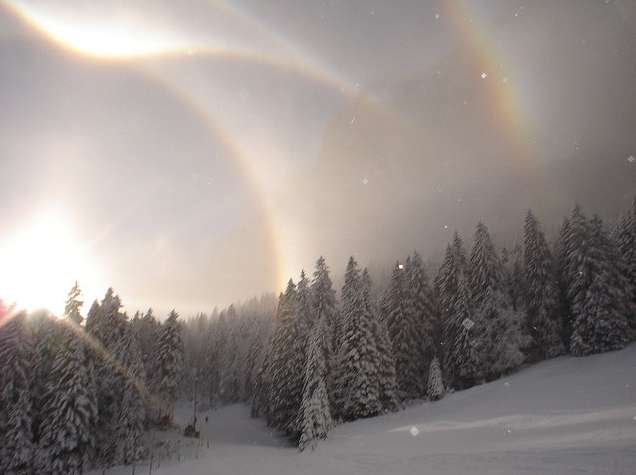
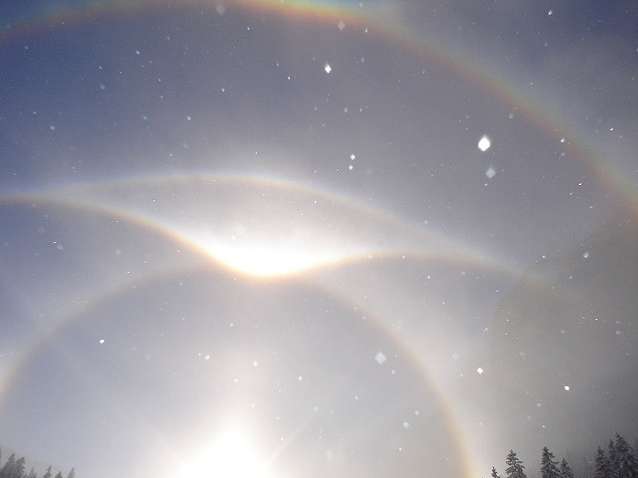
These two amazing photographies were taken in the Melchsee-Frutt region of Switzerland by Max Emerson. They are showing most of the known halos and arcs, including the rarest, like the "Parry supralateral arc" and the "suncave Parry arc"...
Atoptics had made a beautiful and realistic composition of both photography visible in the website HERE, as well as a HaloSim ray tracing simulation showing all of these arcs and their names as well.
Max Emerson also produced a video:
Link to the Original Flickr photographies - © Max Emerson.
Similar sample:
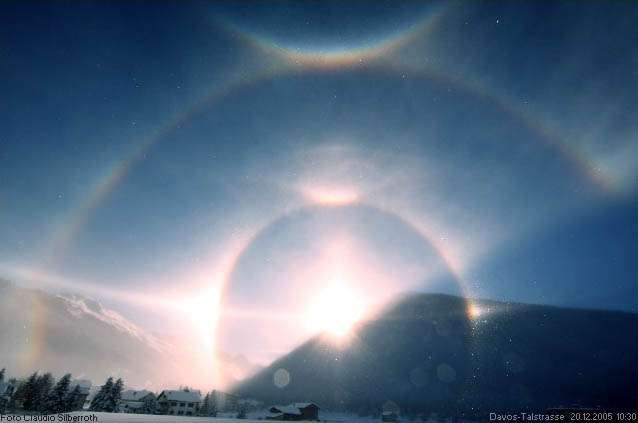
©Claudio Silberroth
------------------------------------------------
Tomorrow: "Alaska Iridescence"
I hope it will serve as an educational manner, that's why I will try to update it everyday with some comments (both from the original site and from me) and similar samples.
Original source - Optics Picture Of The Day
---------------------------------------------------------------------------------
Swiss halos


These two amazing photographies were taken in the Melchsee-Frutt region of Switzerland by Max Emerson. They are showing most of the known halos and arcs, including the rarest, like the "Parry supralateral arc" and the "suncave Parry arc"...
Atoptics had made a beautiful and realistic composition of both photography visible in the website HERE, as well as a HaloSim ray tracing simulation showing all of these arcs and their names as well.
Max Emerson also produced a video:
Link to the Original Flickr photographies - © Max Emerson.
Similar sample:

©Claudio Silberroth
------------------------------------------------
Tomorrow: "Alaska Iridescence"
greta website! i check it almost everyday. they also have a iphone app called APOD for free. has some great things!
Im always awestruck at how beautiful the world is we live in. Thanks for sharing.
Alaska Iridescence
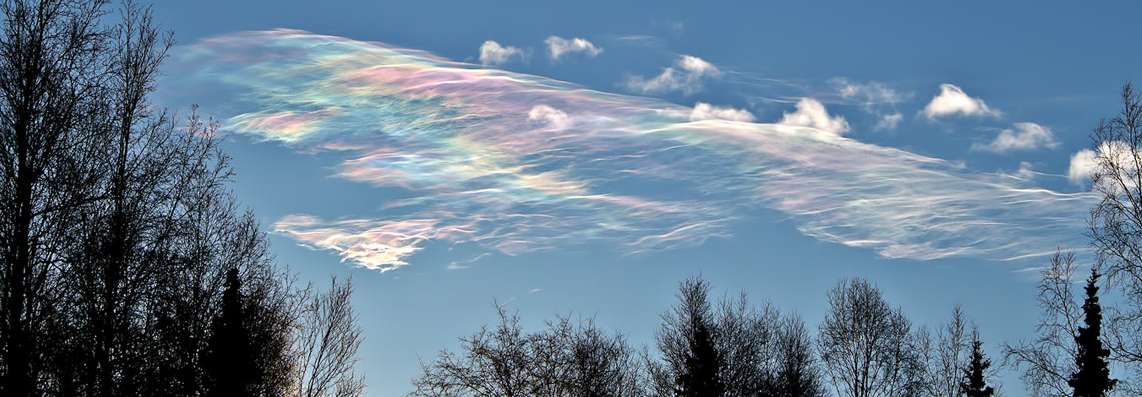
....captured by Doug Short.
"These clouds were changing fast and within 10 minutes were overtaken by a solid layer of clouds. The cloud layer showed some iridescence on its leading edge for a few minutes as it merged with the first clouds."
Credits to Doug Short and Optics Picture Of The Day
Why would clouds appear to be different colors?
A relatively rare phenomenon known as iridescent clouds can show unusual colors vividly or a whole spectrum of colors simultaneously. These clouds are formed of small water droplets of nearly uniform size.
When the Sun is in the right position and mostly hidden by thick clouds, these thinner clouds significantly diffract sunlight in a nearly coherent manner, with different colors being deflected by different amounts. Therefore, different colors will come to the observer from slightly different directions.
Many clouds start with uniform regions that could show iridescence but quickly become too thick, too mixed, or too far from the Sun to exhibit striking colors.
Similar sample:

Credits: Lohmeier Dan
Tomorrow: "Light Pillars at night"

....captured by Doug Short.
"These clouds were changing fast and within 10 minutes were overtaken by a solid layer of clouds. The cloud layer showed some iridescence on its leading edge for a few minutes as it merged with the first clouds."
Credits to Doug Short and Optics Picture Of The Day
Why would clouds appear to be different colors?
A relatively rare phenomenon known as iridescent clouds can show unusual colors vividly or a whole spectrum of colors simultaneously. These clouds are formed of small water droplets of nearly uniform size.
When the Sun is in the right position and mostly hidden by thick clouds, these thinner clouds significantly diffract sunlight in a nearly coherent manner, with different colors being deflected by different amounts. Therefore, different colors will come to the observer from slightly different directions.
Many clouds start with uniform regions that could show iridescence but quickly become too thick, too mixed, or too far from the Sun to exhibit striking colors.
Similar sample:

Credits: Lohmeier Dan
Tomorrow: "Light Pillars at night"
edit on 14-4-2011 by elevenaugust because: (no reason given)
Light pillars at night

Light Pillars, Calgary, Alberta Imaged by Larry McNish (Calgary center RASC).
"Calgary has been experiencing one of the coldest run of February and March temperatures in recent memory. After midnight on March 5 at -20 C, with a light shower of fine falling ice crystals (needle-like) in the air and almost no wind, we spotted these light pillars on just about every sodium and mercury vapour light in the area.
The top is a tripod shot, 1.3 second, f/5.6, ISO 800, 42mm lens.
Sodium streetlights on Sunvalley Blvd. [Canon EOS Digital Rebel XSi]."
Light pillars are usually produced by hexagonal plate-shaped ice crystals in low cloud or in ice fogs at ground level.
The crystals drift very slowly downwards (only a few mm/s) relative to the direction of local air currents. They are not necessarily falling towards the ground.
The drift motion sets up an aerodynamic drag that aligns them with their large hexagonal faces nearly horizontal.
The large faces act as mirrors and glint light from lamps on the ground back downwards.
Sun pillars need crystals that wobble from the horizontal orientation. They can also form light pillars at night but tilted crystals are not essential.
Other crystals sometimes form pillars - sometimes with odd effects.
Credits due to:
Larry McNish (Calgary Center RASC).
Atoptics
Similar samples:

Zenith light pillars
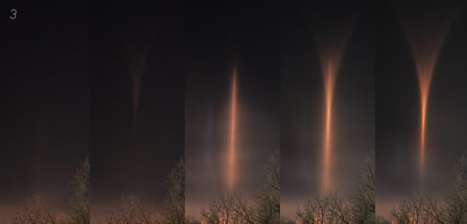
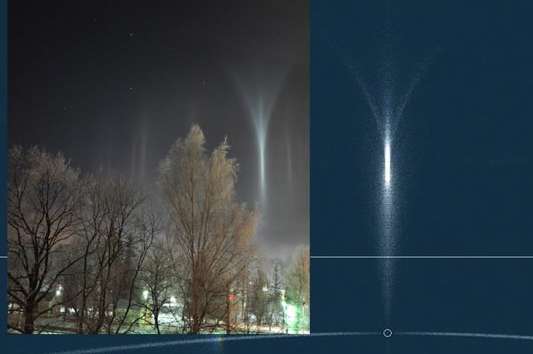
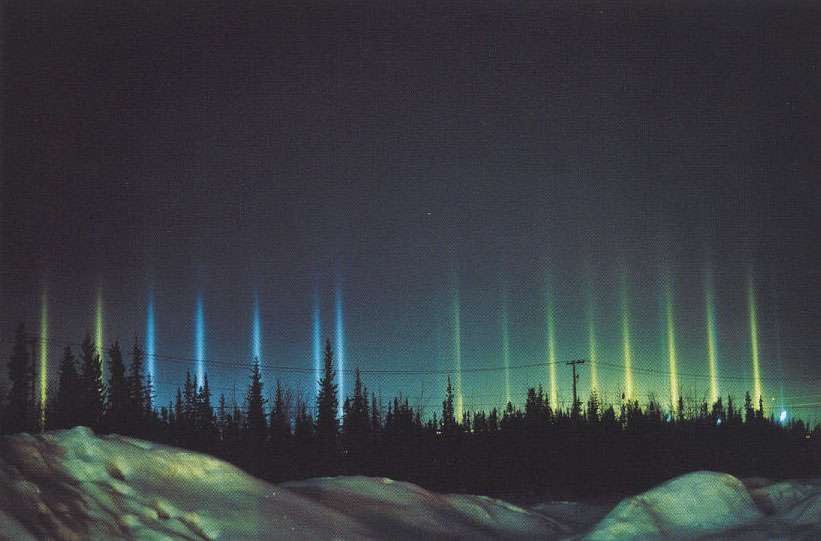
Tomorrow: Flattened sun

Light Pillars, Calgary, Alberta Imaged by Larry McNish (Calgary center RASC).
"Calgary has been experiencing one of the coldest run of February and March temperatures in recent memory. After midnight on March 5 at -20 C, with a light shower of fine falling ice crystals (needle-like) in the air and almost no wind, we spotted these light pillars on just about every sodium and mercury vapour light in the area.
The top is a tripod shot, 1.3 second, f/5.6, ISO 800, 42mm lens.
Sodium streetlights on Sunvalley Blvd. [Canon EOS Digital Rebel XSi]."
Light pillars are usually produced by hexagonal plate-shaped ice crystals in low cloud or in ice fogs at ground level.
The crystals drift very slowly downwards (only a few mm/s) relative to the direction of local air currents. They are not necessarily falling towards the ground.
The drift motion sets up an aerodynamic drag that aligns them with their large hexagonal faces nearly horizontal.
The large faces act as mirrors and glint light from lamps on the ground back downwards.
Sun pillars need crystals that wobble from the horizontal orientation. They can also form light pillars at night but tilted crystals are not essential.
Other crystals sometimes form pillars - sometimes with odd effects.
Credits due to:
Larry McNish (Calgary Center RASC).
Atoptics
Similar samples:

Zenith light pillars



Tomorrow: Flattened sun
new topics
-
Putin, Russia and the Great Architects of the Universe
ATS Skunk Works: 49 minutes ago -
A Warning to America: 25 Ways the US is Being Destroyed
New World Order: 5 hours ago -
President BIDEN's FBI Raided Donald Trump's Florida Home for OBAMA-NORTH KOREA Documents.
Political Conspiracies: 10 hours ago
top topics
-
President BIDEN's FBI Raided Donald Trump's Florida Home for OBAMA-NORTH KOREA Documents.
Political Conspiracies: 10 hours ago, 28 flags -
A Warning to America: 25 Ways the US is Being Destroyed
New World Order: 5 hours ago, 10 flags -
Gaza Terrorists Attack US Humanitarian Pier During Construction
Middle East Issues: 17 hours ago, 8 flags -
Las Vegas UFO Spotting Teen Traumatized by Demon Creature in Backyard
Aliens and UFOs: 16 hours ago, 7 flags -
2024 Pigeon Forge Rod Run - On the Strip (Video made for you)
Automotive Discussion: 16 hours ago, 4 flags -
Is AI Better Than the Hollywood Elite?
Movies: 12 hours ago, 3 flags -
Maestro Benedetto
Literature: 12 hours ago, 1 flags -
Putin, Russia and the Great Architects of the Universe
ATS Skunk Works: 49 minutes ago, 1 flags
1
